Business Law Study Material
VerifiedAdded on 2023/01/06
|9
|2285
|72
AI Summary
Get comprehensive study material on Business Law including topics like liability, contracts, insurance law, and more. Access solved assignments, essays, and dissertations on Business Law at Desklib.
Contribute Materials
Your contribution can guide someone’s learning journey. Share your
documents today.

Business law
Secure Best Marks with AI Grader
Need help grading? Try our AI Grader for instant feedback on your assignments.
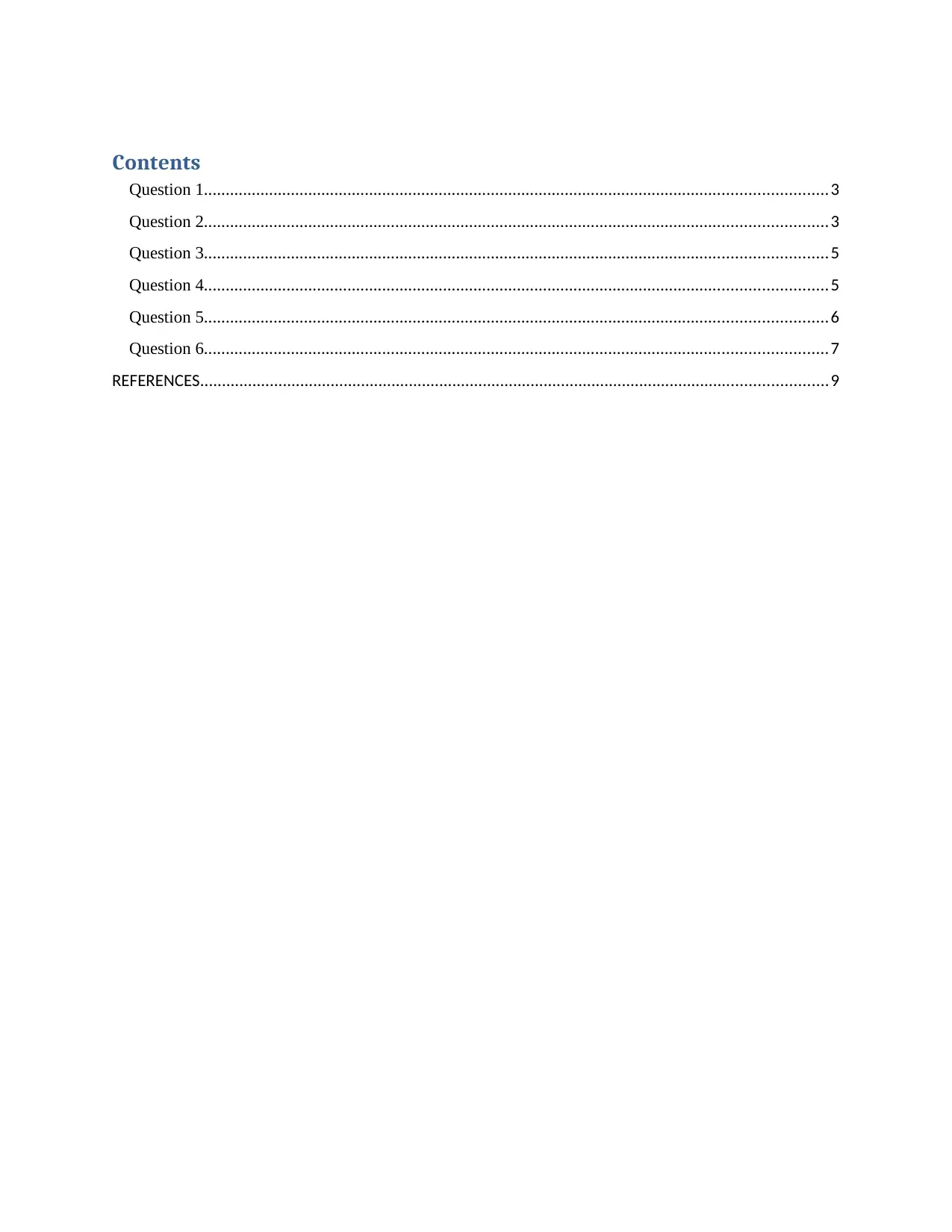
Contents
Question 1...............................................................................................................................................3
Question 2...............................................................................................................................................3
Question 3...............................................................................................................................................5
Question 4...............................................................................................................................................5
Question 5...............................................................................................................................................6
Question 6...............................................................................................................................................7
REFERENCES................................................................................................................................................9
Question 1...............................................................................................................................................3
Question 2...............................................................................................................................................3
Question 3...............................................................................................................................................5
Question 4...............................................................................................................................................5
Question 5...............................................................................................................................................6
Question 6...............................................................................................................................................7
REFERENCES................................................................................................................................................9
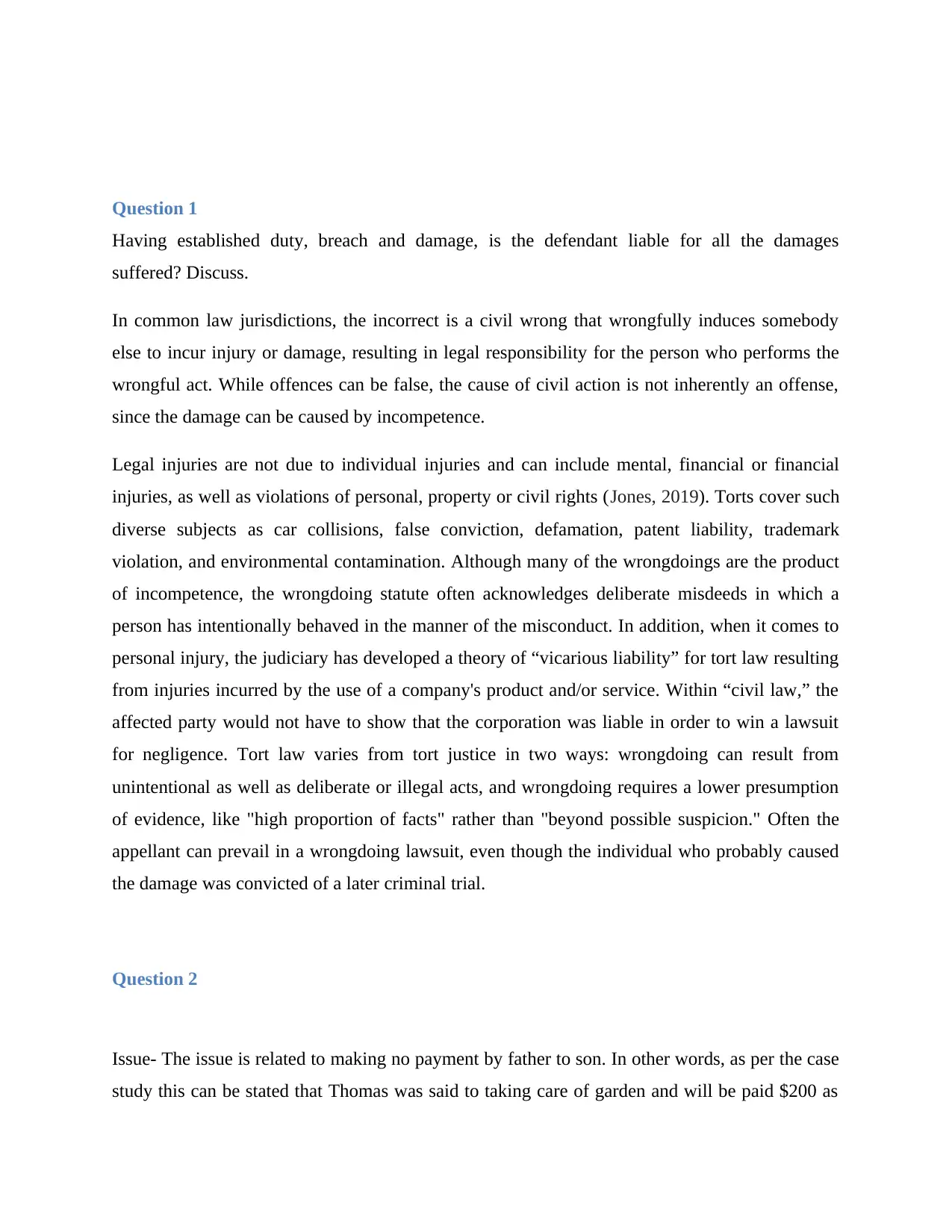
Question 1
Having established duty, breach and damage, is the defendant liable for all the damages
suffered? Discuss.
In common law jurisdictions, the incorrect is a civil wrong that wrongfully induces somebody
else to incur injury or damage, resulting in legal responsibility for the person who performs the
wrongful act. While offences can be false, the cause of civil action is not inherently an offense,
since the damage can be caused by incompetence.
Legal injuries are not due to individual injuries and can include mental, financial or financial
injuries, as well as violations of personal, property or civil rights (Jones, 2019). Torts cover such
diverse subjects as car collisions, false conviction, defamation, patent liability, trademark
violation, and environmental contamination. Although many of the wrongdoings are the product
of incompetence, the wrongdoing statute often acknowledges deliberate misdeeds in which a
person has intentionally behaved in the manner of the misconduct. In addition, when it comes to
personal injury, the judiciary has developed a theory of “vicarious liability” for tort law resulting
from injuries incurred by the use of a company's product and/or service. Within “civil law,” the
affected party would not have to show that the corporation was liable in order to win a lawsuit
for negligence. Tort law varies from tort justice in two ways: wrongdoing can result from
unintentional as well as deliberate or illegal acts, and wrongdoing requires a lower presumption
of evidence, like "high proportion of facts" rather than "beyond possible suspicion." Often the
appellant can prevail in a wrongdoing lawsuit, even though the individual who probably caused
the damage was convicted of a later criminal trial.
Question 2
Issue- The issue is related to making no payment by father to son. In other words, as per the case
study this can be stated that Thomas was said to taking care of garden and will be paid $200 as
Having established duty, breach and damage, is the defendant liable for all the damages
suffered? Discuss.
In common law jurisdictions, the incorrect is a civil wrong that wrongfully induces somebody
else to incur injury or damage, resulting in legal responsibility for the person who performs the
wrongful act. While offences can be false, the cause of civil action is not inherently an offense,
since the damage can be caused by incompetence.
Legal injuries are not due to individual injuries and can include mental, financial or financial
injuries, as well as violations of personal, property or civil rights (Jones, 2019). Torts cover such
diverse subjects as car collisions, false conviction, defamation, patent liability, trademark
violation, and environmental contamination. Although many of the wrongdoings are the product
of incompetence, the wrongdoing statute often acknowledges deliberate misdeeds in which a
person has intentionally behaved in the manner of the misconduct. In addition, when it comes to
personal injury, the judiciary has developed a theory of “vicarious liability” for tort law resulting
from injuries incurred by the use of a company's product and/or service. Within “civil law,” the
affected party would not have to show that the corporation was liable in order to win a lawsuit
for negligence. Tort law varies from tort justice in two ways: wrongdoing can result from
unintentional as well as deliberate or illegal acts, and wrongdoing requires a lower presumption
of evidence, like "high proportion of facts" rather than "beyond possible suspicion." Often the
appellant can prevail in a wrongdoing lawsuit, even though the individual who probably caused
the damage was convicted of a later criminal trial.
Question 2
Issue- The issue is related to making no payment by father to son. In other words, as per the case
study this can be stated that Thomas was said to taking care of garden and will be paid $200 as
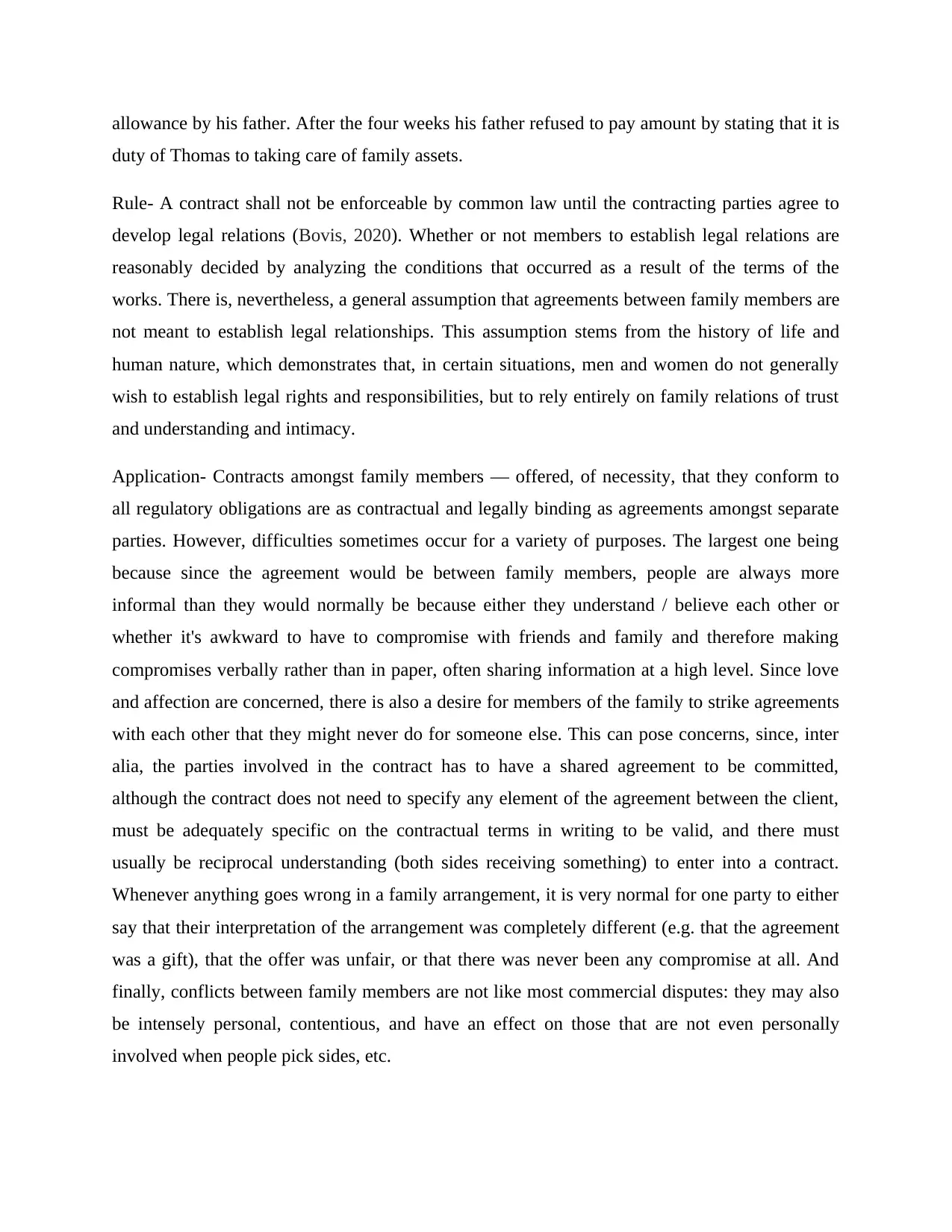
allowance by his father. After the four weeks his father refused to pay amount by stating that it is
duty of Thomas to taking care of family assets.
Rule- A contract shall not be enforceable by common law until the contracting parties agree to
develop legal relations (Bovis, 2020). Whether or not members to establish legal relations are
reasonably decided by analyzing the conditions that occurred as a result of the terms of the
works. There is, nevertheless, a general assumption that agreements between family members are
not meant to establish legal relationships. This assumption stems from the history of life and
human nature, which demonstrates that, in certain situations, men and women do not generally
wish to establish legal rights and responsibilities, but to rely entirely on family relations of trust
and understanding and intimacy.
Application- Contracts amongst family members — offered, of necessity, that they conform to
all regulatory obligations are as contractual and legally binding as agreements amongst separate
parties. However, difficulties sometimes occur for a variety of purposes. The largest one being
because since the agreement would be between family members, people are always more
informal than they would normally be because either they understand / believe each other or
whether it's awkward to have to compromise with friends and family and therefore making
compromises verbally rather than in paper, often sharing information at a high level. Since love
and affection are concerned, there is also a desire for members of the family to strike agreements
with each other that they might never do for someone else. This can pose concerns, since, inter
alia, the parties involved in the contract has to have a shared agreement to be committed,
although the contract does not need to specify any element of the agreement between the client,
must be adequately specific on the contractual terms in writing to be valid, and there must
usually be reciprocal understanding (both sides receiving something) to enter into a contract.
Whenever anything goes wrong in a family arrangement, it is very normal for one party to either
say that their interpretation of the arrangement was completely different (e.g. that the agreement
was a gift), that the offer was unfair, or that there was never been any compromise at all. And
finally, conflicts between family members are not like most commercial disputes: they may also
be intensely personal, contentious, and have an effect on those that are not even personally
involved when people pick sides, etc.
duty of Thomas to taking care of family assets.
Rule- A contract shall not be enforceable by common law until the contracting parties agree to
develop legal relations (Bovis, 2020). Whether or not members to establish legal relations are
reasonably decided by analyzing the conditions that occurred as a result of the terms of the
works. There is, nevertheless, a general assumption that agreements between family members are
not meant to establish legal relationships. This assumption stems from the history of life and
human nature, which demonstrates that, in certain situations, men and women do not generally
wish to establish legal rights and responsibilities, but to rely entirely on family relations of trust
and understanding and intimacy.
Application- Contracts amongst family members — offered, of necessity, that they conform to
all regulatory obligations are as contractual and legally binding as agreements amongst separate
parties. However, difficulties sometimes occur for a variety of purposes. The largest one being
because since the agreement would be between family members, people are always more
informal than they would normally be because either they understand / believe each other or
whether it's awkward to have to compromise with friends and family and therefore making
compromises verbally rather than in paper, often sharing information at a high level. Since love
and affection are concerned, there is also a desire for members of the family to strike agreements
with each other that they might never do for someone else. This can pose concerns, since, inter
alia, the parties involved in the contract has to have a shared agreement to be committed,
although the contract does not need to specify any element of the agreement between the client,
must be adequately specific on the contractual terms in writing to be valid, and there must
usually be reciprocal understanding (both sides receiving something) to enter into a contract.
Whenever anything goes wrong in a family arrangement, it is very normal for one party to either
say that their interpretation of the arrangement was completely different (e.g. that the agreement
was a gift), that the offer was unfair, or that there was never been any compromise at all. And
finally, conflicts between family members are not like most commercial disputes: they may also
be intensely personal, contentious, and have an effect on those that are not even personally
involved when people pick sides, etc.
Secure Best Marks with AI Grader
Need help grading? Try our AI Grader for instant feedback on your assignments.
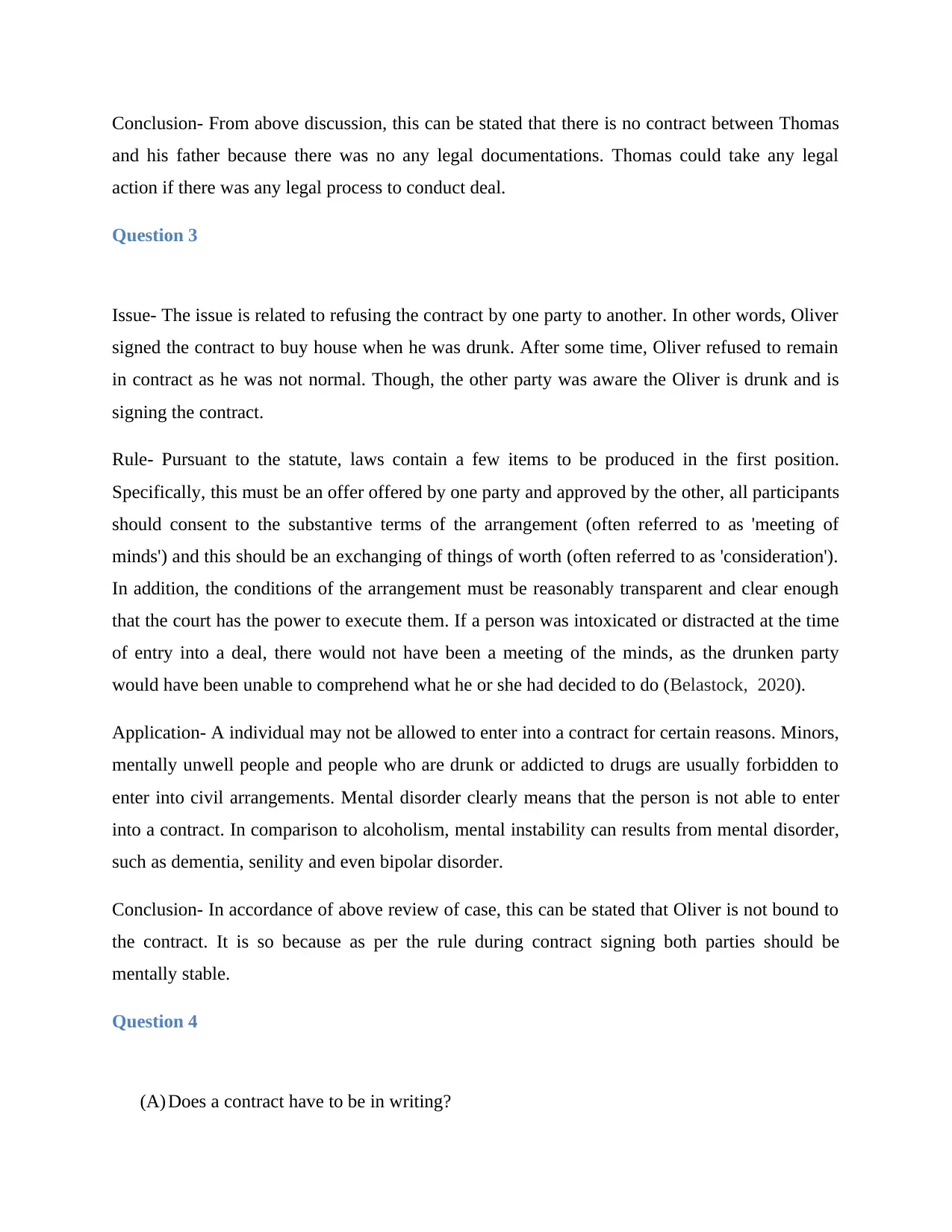
Conclusion- From above discussion, this can be stated that there is no contract between Thomas
and his father because there was no any legal documentations. Thomas could take any legal
action if there was any legal process to conduct deal.
Question 3
Issue- The issue is related to refusing the contract by one party to another. In other words, Oliver
signed the contract to buy house when he was drunk. After some time, Oliver refused to remain
in contract as he was not normal. Though, the other party was aware the Oliver is drunk and is
signing the contract.
Rule- Pursuant to the statute, laws contain a few items to be produced in the first position.
Specifically, this must be an offer offered by one party and approved by the other, all participants
should consent to the substantive terms of the arrangement (often referred to as 'meeting of
minds') and this should be an exchanging of things of worth (often referred to as 'consideration').
In addition, the conditions of the arrangement must be reasonably transparent and clear enough
that the court has the power to execute them. If a person was intoxicated or distracted at the time
of entry into a deal, there would not have been a meeting of the minds, as the drunken party
would have been unable to comprehend what he or she had decided to do (Belastock, 2020).
Application- A individual may not be allowed to enter into a contract for certain reasons. Minors,
mentally unwell people and people who are drunk or addicted to drugs are usually forbidden to
enter into civil arrangements. Mental disorder clearly means that the person is not able to enter
into a contract. In comparison to alcoholism, mental instability can results from mental disorder,
such as dementia, senility and even bipolar disorder.
Conclusion- In accordance of above review of case, this can be stated that Oliver is not bound to
the contract. It is so because as per the rule during contract signing both parties should be
mentally stable.
Question 4
(A) Does a contract have to be in writing?
and his father because there was no any legal documentations. Thomas could take any legal
action if there was any legal process to conduct deal.
Question 3
Issue- The issue is related to refusing the contract by one party to another. In other words, Oliver
signed the contract to buy house when he was drunk. After some time, Oliver refused to remain
in contract as he was not normal. Though, the other party was aware the Oliver is drunk and is
signing the contract.
Rule- Pursuant to the statute, laws contain a few items to be produced in the first position.
Specifically, this must be an offer offered by one party and approved by the other, all participants
should consent to the substantive terms of the arrangement (often referred to as 'meeting of
minds') and this should be an exchanging of things of worth (often referred to as 'consideration').
In addition, the conditions of the arrangement must be reasonably transparent and clear enough
that the court has the power to execute them. If a person was intoxicated or distracted at the time
of entry into a deal, there would not have been a meeting of the minds, as the drunken party
would have been unable to comprehend what he or she had decided to do (Belastock, 2020).
Application- A individual may not be allowed to enter into a contract for certain reasons. Minors,
mentally unwell people and people who are drunk or addicted to drugs are usually forbidden to
enter into civil arrangements. Mental disorder clearly means that the person is not able to enter
into a contract. In comparison to alcoholism, mental instability can results from mental disorder,
such as dementia, senility and even bipolar disorder.
Conclusion- In accordance of above review of case, this can be stated that Oliver is not bound to
the contract. It is so because as per the rule during contract signing both parties should be
mentally stable.
Question 4
(A) Does a contract have to be in writing?
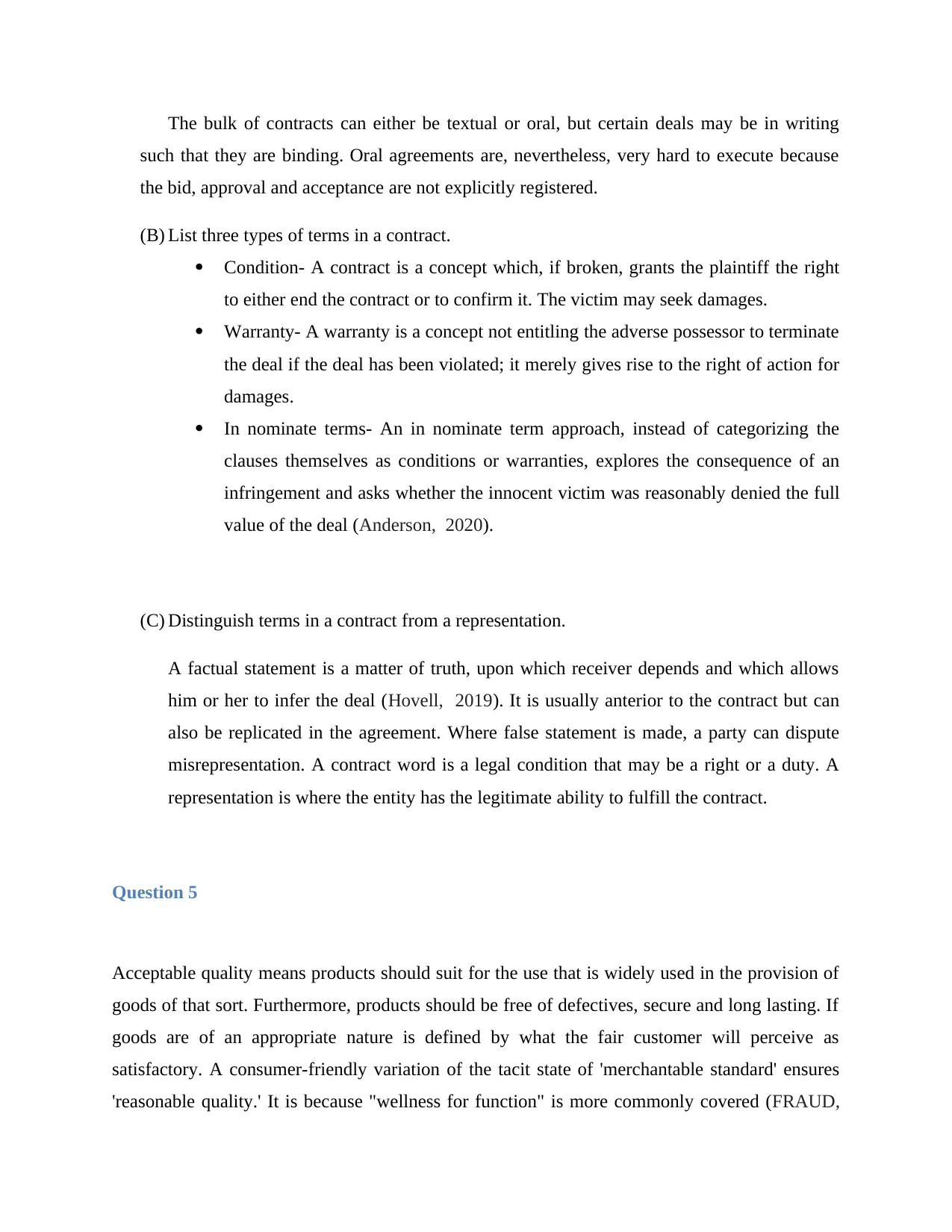
The bulk of contracts can either be textual or oral, but certain deals may be in writing
such that they are binding. Oral agreements are, nevertheless, very hard to execute because
the bid, approval and acceptance are not explicitly registered.
(B) List three types of terms in a contract.
Condition- A contract is a concept which, if broken, grants the plaintiff the right
to either end the contract or to confirm it. The victim may seek damages.
Warranty- A warranty is a concept not entitling the adverse possessor to terminate
the deal if the deal has been violated; it merely gives rise to the right of action for
damages.
In nominate terms- An in nominate term approach, instead of categorizing the
clauses themselves as conditions or warranties, explores the consequence of an
infringement and asks whether the innocent victim was reasonably denied the full
value of the deal (Anderson, 2020).
(C) Distinguish terms in a contract from a representation.
A factual statement is a matter of truth, upon which receiver depends and which allows
him or her to infer the deal (Hovell, 2019). It is usually anterior to the contract but can
also be replicated in the agreement. Where false statement is made, a party can dispute
misrepresentation. A contract word is a legal condition that may be a right or a duty. A
representation is where the entity has the legitimate ability to fulfill the contract.
Question 5
Acceptable quality means products should suit for the use that is widely used in the provision of
goods of that sort. Furthermore, products should be free of defectives, secure and long lasting. If
goods are of an appropriate nature is defined by what the fair customer will perceive as
satisfactory. A consumer-friendly variation of the tacit state of 'merchantable standard' ensures
'reasonable quality.' It is because "wellness for function" is more commonly covered (FRAUD,
such that they are binding. Oral agreements are, nevertheless, very hard to execute because
the bid, approval and acceptance are not explicitly registered.
(B) List three types of terms in a contract.
Condition- A contract is a concept which, if broken, grants the plaintiff the right
to either end the contract or to confirm it. The victim may seek damages.
Warranty- A warranty is a concept not entitling the adverse possessor to terminate
the deal if the deal has been violated; it merely gives rise to the right of action for
damages.
In nominate terms- An in nominate term approach, instead of categorizing the
clauses themselves as conditions or warranties, explores the consequence of an
infringement and asks whether the innocent victim was reasonably denied the full
value of the deal (Anderson, 2020).
(C) Distinguish terms in a contract from a representation.
A factual statement is a matter of truth, upon which receiver depends and which allows
him or her to infer the deal (Hovell, 2019). It is usually anterior to the contract but can
also be replicated in the agreement. Where false statement is made, a party can dispute
misrepresentation. A contract word is a legal condition that may be a right or a duty. A
representation is where the entity has the legitimate ability to fulfill the contract.
Question 5
Acceptable quality means products should suit for the use that is widely used in the provision of
goods of that sort. Furthermore, products should be free of defectives, secure and long lasting. If
goods are of an appropriate nature is defined by what the fair customer will perceive as
satisfactory. A consumer-friendly variation of the tacit state of 'merchantable standard' ensures
'reasonable quality.' It is because "wellness for function" is more commonly covered (FRAUD,
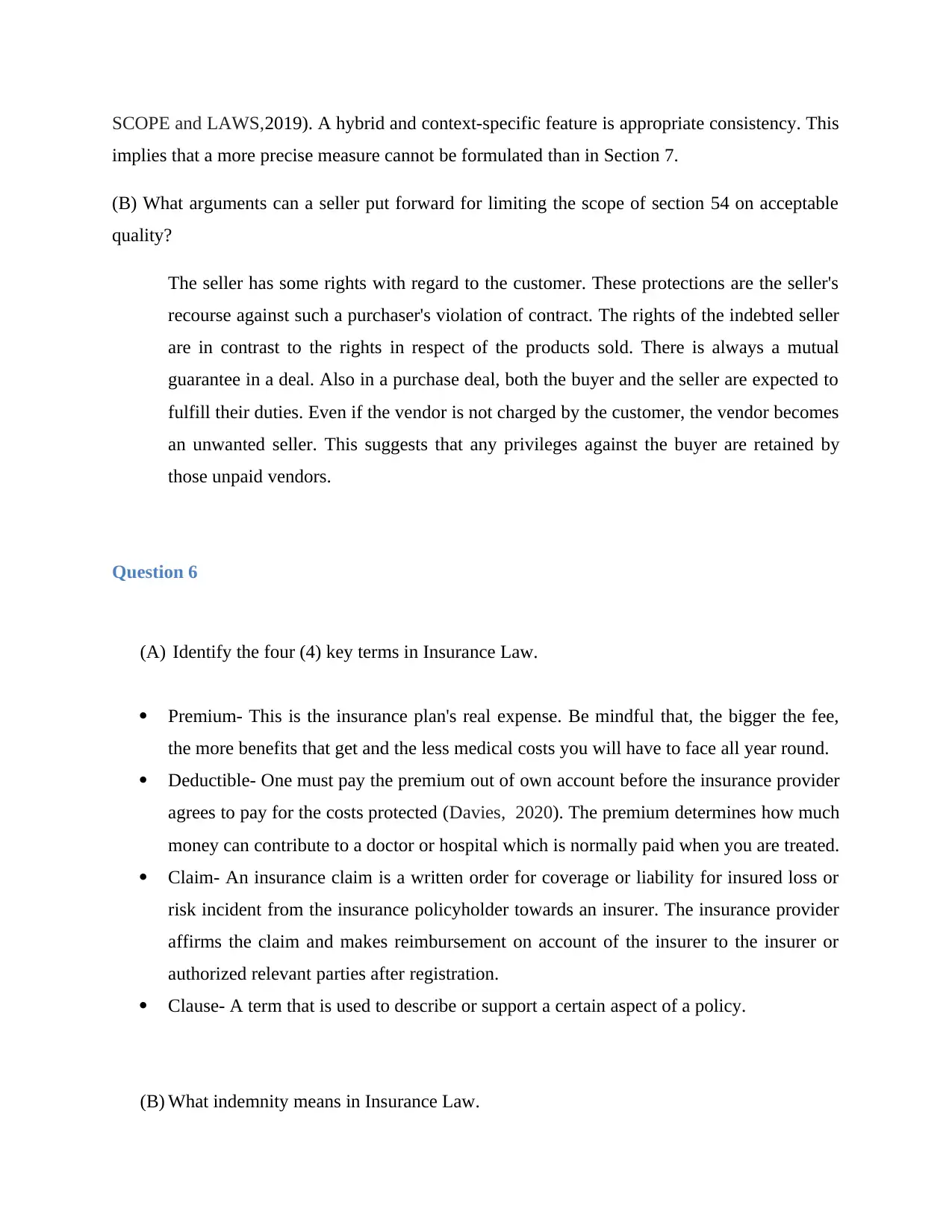
SCOPE and LAWS,2019). A hybrid and context-specific feature is appropriate consistency. This
implies that a more precise measure cannot be formulated than in Section 7.
(B) What arguments can a seller put forward for limiting the scope of section 54 on acceptable
quality?
The seller has some rights with regard to the customer. These protections are the seller's
recourse against such a purchaser's violation of contract. The rights of the indebted seller
are in contrast to the rights in respect of the products sold. There is always a mutual
guarantee in a deal. Also in a purchase deal, both the buyer and the seller are expected to
fulfill their duties. Even if the vendor is not charged by the customer, the vendor becomes
an unwanted seller. This suggests that any privileges against the buyer are retained by
those unpaid vendors.
Question 6
(A) Identify the four (4) key terms in Insurance Law.
Premium- This is the insurance plan's real expense. Be mindful that, the bigger the fee,
the more benefits that get and the less medical costs you will have to face all year round.
Deductible- One must pay the premium out of own account before the insurance provider
agrees to pay for the costs protected (Davies, 2020). The premium determines how much
money can contribute to a doctor or hospital which is normally paid when you are treated.
Claim- An insurance claim is a written order for coverage or liability for insured loss or
risk incident from the insurance policyholder towards an insurer. The insurance provider
affirms the claim and makes reimbursement on account of the insurer to the insurer or
authorized relevant parties after registration.
Clause- A term that is used to describe or support a certain aspect of a policy.
(B) What indemnity means in Insurance Law.
implies that a more precise measure cannot be formulated than in Section 7.
(B) What arguments can a seller put forward for limiting the scope of section 54 on acceptable
quality?
The seller has some rights with regard to the customer. These protections are the seller's
recourse against such a purchaser's violation of contract. The rights of the indebted seller
are in contrast to the rights in respect of the products sold. There is always a mutual
guarantee in a deal. Also in a purchase deal, both the buyer and the seller are expected to
fulfill their duties. Even if the vendor is not charged by the customer, the vendor becomes
an unwanted seller. This suggests that any privileges against the buyer are retained by
those unpaid vendors.
Question 6
(A) Identify the four (4) key terms in Insurance Law.
Premium- This is the insurance plan's real expense. Be mindful that, the bigger the fee,
the more benefits that get and the less medical costs you will have to face all year round.
Deductible- One must pay the premium out of own account before the insurance provider
agrees to pay for the costs protected (Davies, 2020). The premium determines how much
money can contribute to a doctor or hospital which is normally paid when you are treated.
Claim- An insurance claim is a written order for coverage or liability for insured loss or
risk incident from the insurance policyholder towards an insurer. The insurance provider
affirms the claim and makes reimbursement on account of the insurer to the insurer or
authorized relevant parties after registration.
Clause- A term that is used to describe or support a certain aspect of a policy.
(B) What indemnity means in Insurance Law.
Paraphrase This Document
Need a fresh take? Get an instant paraphrase of this document with our AI Paraphraser
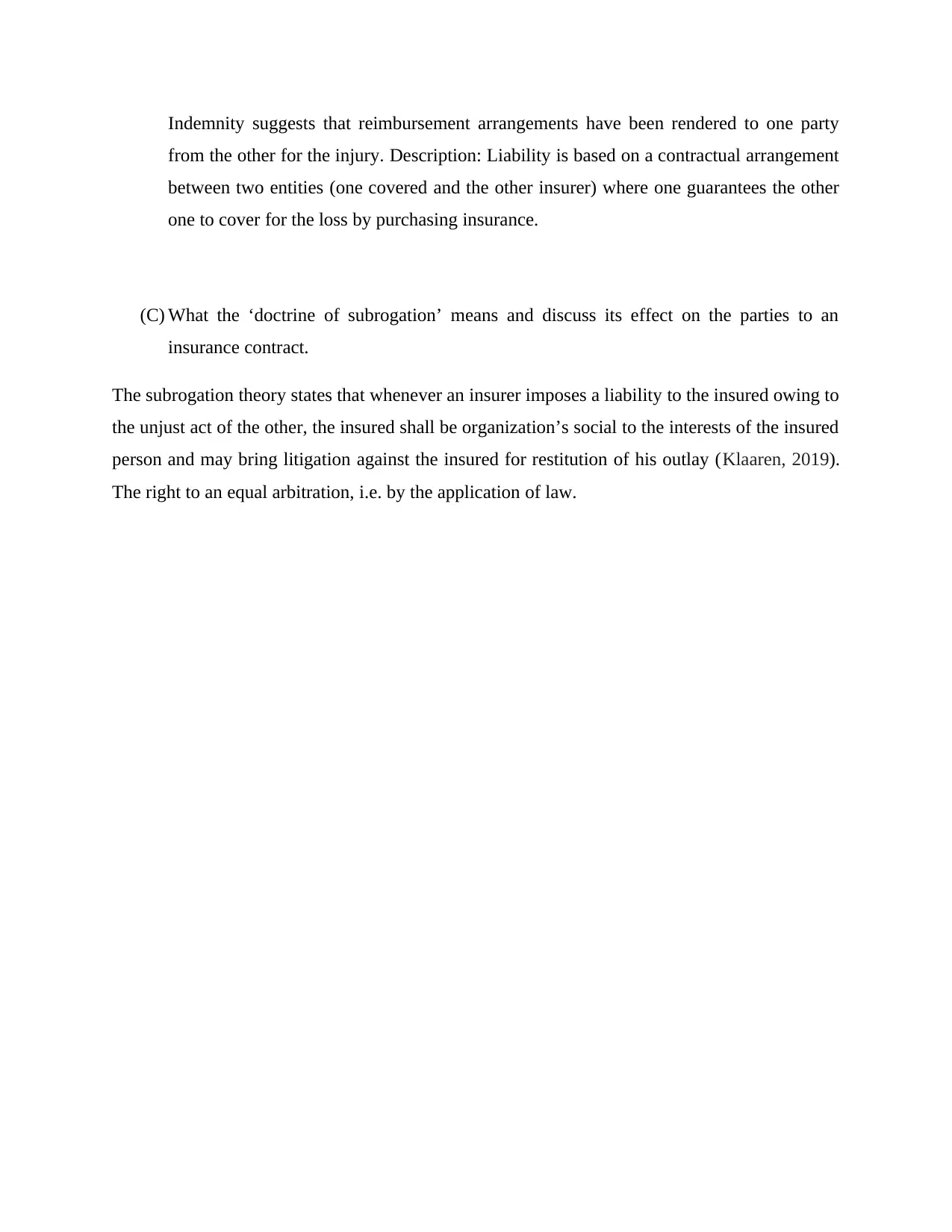
Indemnity suggests that reimbursement arrangements have been rendered to one party
from the other for the injury. Description: Liability is based on a contractual arrangement
between two entities (one covered and the other insurer) where one guarantees the other
one to cover for the loss by purchasing insurance.
(C) What the ‘doctrine of subrogation’ means and discuss its effect on the parties to an
insurance contract.
The subrogation theory states that whenever an insurer imposes a liability to the insured owing to
the unjust act of the other, the insured shall be organization’s social to the interests of the insured
person and may bring litigation against the insured for restitution of his outlay (Klaaren, 2019).
The right to an equal arbitration, i.e. by the application of law.
from the other for the injury. Description: Liability is based on a contractual arrangement
between two entities (one covered and the other insurer) where one guarantees the other
one to cover for the loss by purchasing insurance.
(C) What the ‘doctrine of subrogation’ means and discuss its effect on the parties to an
insurance contract.
The subrogation theory states that whenever an insurer imposes a liability to the insured owing to
the unjust act of the other, the insured shall be organization’s social to the interests of the insured
person and may bring litigation against the insured for restitution of his outlay (Klaaren, 2019).
The right to an equal arbitration, i.e. by the application of law.

REFERENCES
Jones, L., 2019. Introduction to business law. Oxford University Press, USA.
Bovis, C., 2020. The law of EU public procurement. Oxford University Press (OUP).
Belastock, T.N., 2020. Legal resources in an academic business library. College & research
libraries news, 48(11), pp.684-687.
Anderson, R., 2020. Path Dependence, Information, and Contracting in Business Law and
Economics. Wisconsin Law Review, Forthcoming.
Hovell, D., 2019. Unfinished Business of International Law: The Questionable Legality of
Autonomous Sanctions. AJIL Unbound, 113, pp.140-145.
FRAUD, I.H., SCOPE, I. and LAWS, A., 2020. WILLIAM & MARY BUSINESS LAW
REVIEW.
Davies, P., 2020. Introduction to company law. Oxford University Press.
Klaaren, J., 2019. Laying the table: the role of business in establishing competition law and
policy in South Africa. International Review of Applied Economics, 33(1), pp.119-133.
Jones, L., 2019. Introduction to business law. Oxford University Press, USA.
Bovis, C., 2020. The law of EU public procurement. Oxford University Press (OUP).
Belastock, T.N., 2020. Legal resources in an academic business library. College & research
libraries news, 48(11), pp.684-687.
Anderson, R., 2020. Path Dependence, Information, and Contracting in Business Law and
Economics. Wisconsin Law Review, Forthcoming.
Hovell, D., 2019. Unfinished Business of International Law: The Questionable Legality of
Autonomous Sanctions. AJIL Unbound, 113, pp.140-145.
FRAUD, I.H., SCOPE, I. and LAWS, A., 2020. WILLIAM & MARY BUSINESS LAW
REVIEW.
Davies, P., 2020. Introduction to company law. Oxford University Press.
Klaaren, J., 2019. Laying the table: the role of business in establishing competition law and
policy in South Africa. International Review of Applied Economics, 33(1), pp.119-133.
1 out of 9
Related Documents
Your All-in-One AI-Powered Toolkit for Academic Success.
+13062052269
info@desklib.com
Available 24*7 on WhatsApp / Email
![[object Object]](/_next/static/media/star-bottom.7253800d.svg)
Unlock your academic potential
© 2024 | Zucol Services PVT LTD | All rights reserved.




